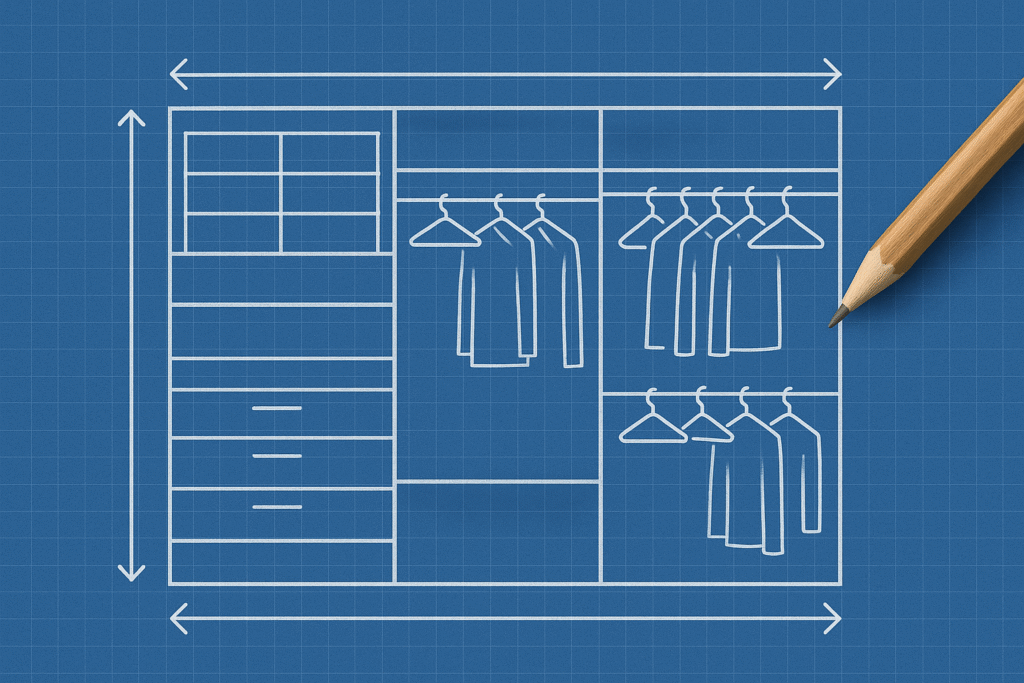How to Plan a Closet Layout

A closet is more than just a storage space. It is an essential part of your home that affects how you start and end each day. A well-planned closet layout makes your space feel organized, functional, and even luxurious. Whether you are working with a reach-in closet, a walk-in, or a full dressing room, thoughtful planning ensures that every inch is used effectively.
If you are wondering how to plan a closet layout that suits your lifestyle and maximizes space, this guide will walk you through the key steps and design choices.
Step 1: Assess Your Needs
The first step in planning any closet layout is to understand your personal storage needs. Take inventory of your wardrobe. Do you have more hanging clothes or folded items? Do you own a large shoe collection? Do you need dedicated space for handbags, accessories, or seasonal clothing?
By identifying what you need to store, you can plan the closet around your lifestyle instead of forcing your items into a generic design. For example, someone with a professional wardrobe may need more double hanging rods for suits and dresses, while a casual dresser may prioritize shelves and drawers.
Step 2: Measure Your Space
Accurate measurements are the foundation of any successful closet design. Measure the height, width, and depth of your closet area. Take note of obstructions like windows, doors, vents, or angled ceilings. These details will help determine what type of storage system can be installed and how to divide the space.
Remember to measure both floor-to-ceiling and wall-to-wall. Height is especially important because vertical storage often makes the difference between a cramped closet and one that feels spacious and efficient.
Step 3: Choose the Right Type of Closet
Not all closets are created equal. The type of closet you have will influence the layout possibilities.
- Reach-in closet: Usually shallow and enclosed with sliding or hinged doors. Best for efficient hanging space and shelving.
- Walk-in closet: Larger with room to walk inside. Allows for creative layouts with islands, seating, and customized sections.
- Wardrobe or armoire: A freestanding option that can be moved and adjusted. Best for rooms without built-in closet space.
Deciding the type of closet you want (or currently have) helps set realistic expectations for your layout.
Step 4: Divide the Space into Zones
An organized closet often works best when divided into functional zones. Common zones include:
- Hanging space: For dresses, shirts, jackets, and pants.
- Shelving: For folded clothing like sweaters, jeans, and t-shirts.
- Drawers: For undergarments, socks, and smaller items.
- Shoe storage: Slanted shelves, cubbies, or pull-out racks.
- Accessory space: Hooks, pull-out trays, or specialized compartments for belts, ties, handbags, or jewelry.
By creating zones, you ensure everything has a designated spot. This avoids clutter and makes getting dressed faster and more enjoyable.
Step 5: Maximize Vertical Storage
One of the biggest mistakes in closet planning is leaving vertical space unused. Floor-to-ceiling designs make the most of available height. Add double hanging rods to store short clothing like shirts and pants. Install upper shelves for seasonal items or storage bins.
If you have a walk-in closet, consider tall shelving units or a ladder system for reaching higher compartments. Making use of vertical space not only increases storage but also makes the closet look more structured and expensive.
Step 6: Select the Right Accessories and Organizers
Closet accessories make a big difference in functionality. Pull-out drawers, shoe racks, jewelry trays, and tie holders keep your items neat and accessible. Drawer dividers are excellent for small items, while pull-out hampers keep laundry out of sight.
Hooks on side walls or inside doors are great for belts and scarves. Adding storage boxes or baskets can also help group smaller accessories while maintaining a clean look.
Step 7: Plan for Lighting
Lighting is often overlooked but can transform the feel of your closet. Good lighting makes your closet easier to use and adds a touch of luxury. Consider recessed ceiling lights, LED strip lights under shelves, or illuminated rods. If you want a statement piece, add a chandelier or pendant light in a walk-in closet.
Proper lighting not only improves visibility but also highlights your wardrobe, making it look more appealing and organized.
Step 8: Think About Aesthetics
A functional layout should also look beautiful. Your closet can reflect your personal style, just like the rest of your home. Choose finishes and materials that complement your bedroom or dressing room. Neutral tones like white, beige, or grey make the space feel larger, while darker woods like walnut or espresso create a more luxurious atmosphere.
Glass doors, mirrored panels, and high-quality hardware add elegance to any closet. Even small details like consistent hangers or neatly labeled bins can make the space look refined.
Step 9: Leave Room for Growth
Your wardrobe will evolve over time. A closet that looks perfect today may feel cramped a year from now if you do not allow space for future additions. Plan extra shelves, adjustable rods, or modular systems that can adapt as your storage needs change.
Leaving flexibility in your design ensures your closet continues to serve you for years without requiring a full remodel.
Step 10: Consider Professional Design Help
While it is possible to plan a closet layout on your own, working with a professional can take your project to the next level. A designer can create a custom plan tailored to your exact space and lifestyle, making sure no detail is overlooked. They can also recommend high-quality finishes and solutions that you may not have considered.
In many cases, investing in a professionally designed closet saves money in the long run because it prevents costly mistakes and maximizes your investment.
Common Mistakes to Avoid
When planning your closet layout, watch out for these common errors:
- Not measuring accurately: Even small measurement mistakes can lead to wasted space.
- Overcrowding: Trying to fit too much can make the closet feel cramped.
- Ignoring lighting: A poorly lit closet feels dull and less functional.
- Lack of organization systems: Without dividers, trays, or zones, clutter will creep back in.
- Neglecting accessibility: Items stored too high or too deep may never be used.
Avoiding these pitfalls ensures that your closet is both practical and enjoyable to use.
Conclusion
Planning a closet layout requires careful thought, from assessing your wardrobe needs to choosing finishes that reflect your style. By dividing the space into zones, maximizing vertical storage, and adding thoughtful accessories, you can create a closet that is not only functional but also beautiful. Lighting, organization, and flexibility all play a role in making your closet a space you love.
If you are ready to take your storage to the next level, Ottawa Custom Closet Solutions can help. We specialize in designing closets that maximize space while reflecting your personal style. From reach-ins to walk-ins, we create layouts that are practical, elegant, and built for your lifestyle. Contact Ottawa Custom Closet Solutions today to start planning the perfect closet for your home.
